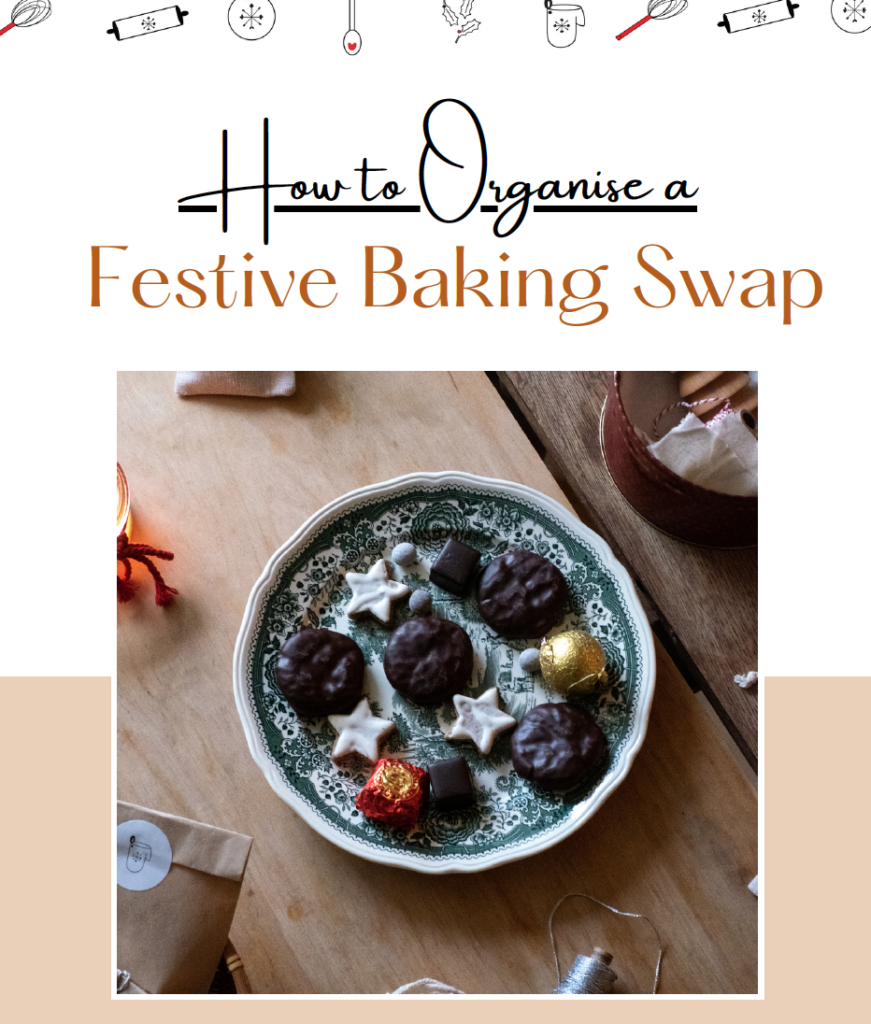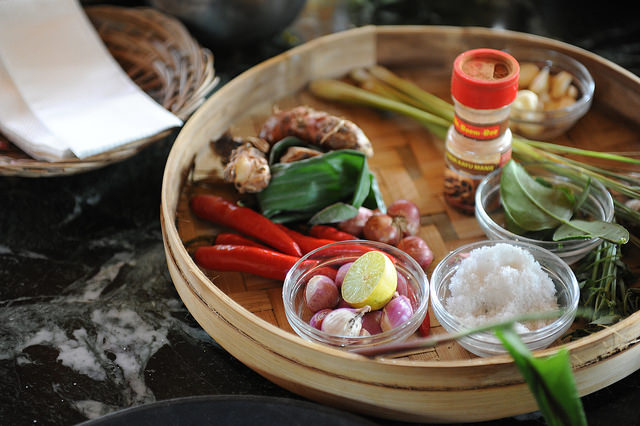 Indonesian ingredients – image by Anggara Mahendra
Indonesian ingredients – image by Anggara Mahendra
Indonesian Food – An overview and recipes
In this Foodie Profile I had the honour of chatting with Ibu Sisca Soewitomo, one of Indonesia’s most prolific cooks and food personalities. She shares her thoughts on what defines Indonesian cuisine and how to recreate some of her dishes at home.
Ibu Sisca Soewitomo is dubbed as the ‘Queen of Indonesian Cuisine’. She has dedicated her 50-year career to nourishing Indonesia’s evolving culinary scene. A pioneer of Indonesian TV cooking, many an aspiring young chef has tuned-in to watch this revered Ibu dish up national favourites. Author of almost 150 cookbooks, Soewitomo has worked in food styling for Indonesia’s biggest food brands, and has been the recipient of many awards for her culinary achievements.
give us
By Jen Curcio
1. Ibu Soewitomo, could you give us an overview on what kind of food encompasses Indonesian cuisine?
Indonesian food is full of spices; onion, garlic, clove, nutmeg, cinnamon, fennel, lemongrass, cumin, coriander, turmeric, and many more. We pair these with main ingredients like fermented soybean (tempe), tofu, fish, egg, beef and vegtables, with a mix of coconut milk and sweet soy sauce.
2. Are there different Indonesian dishes made at different seasons throughout the year and what are they?
We only have two seasons in a year; summer and the rainy season. But, we do have seasonal fruits like durian, rambutan and mango, which feature heavily in the summertime.
 Suckling pork at the infamous Ibu Oka in Ubud – for our favourite spots in Ubud, check out our Bali Food Mini Guide.
Suckling pork at the infamous Ibu Oka in Ubud – for our favourite spots in Ubud, check out our Bali Food Mini Guide.
3. Indonesia is made up of a myriad of islands all with their own culinary culture and history. Could you give us a brief overview of the cooking found in different regions and which type of regional cooking is your favourite?
Indonesian dishes across the archipelago are really different. People use more spices in the Eastern part of Indonesia, and dishes are heavier in taste and texture. My favourites are from Aceh, like Mie Aceh or Acehnese noodles, or from Medan, with Longton Sayur (rice cake and vegetables in a coconut milk soup). I actually can’t choose which region is my favourite but I do have a favourite from each region!
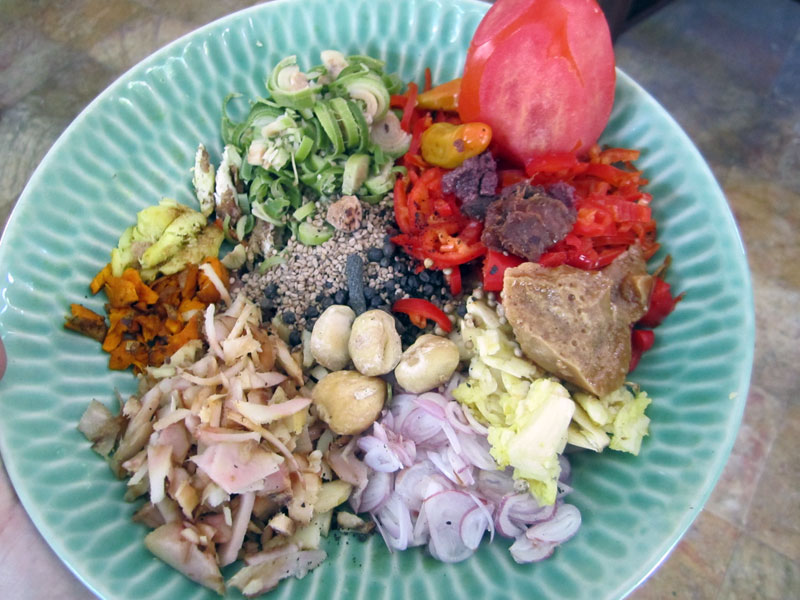 A bowl of fragrant and fresh Indonesian ingredients used to make sambal at a Balinese cooking course a few years ago
A bowl of fragrant and fresh Indonesian ingredients used to make sambal at a Balinese cooking course a few years ago
4. Which staple ingredients will help one get Indonesian cooking ready?
Spices! Indonesian dishes are always mouth watering, aromatic, beautiful with lots of colours and we use spices to achieve that.
5. Who are some of the key producers and chefs in Indonesian cooking today?
For chefs, there are Bara Pattiradjawane and William Wongso, who will be appearing at this year’s Ubud Food Festival, as well as Henry Bloem, Rudy Choirudin, and Haryo Pramu.
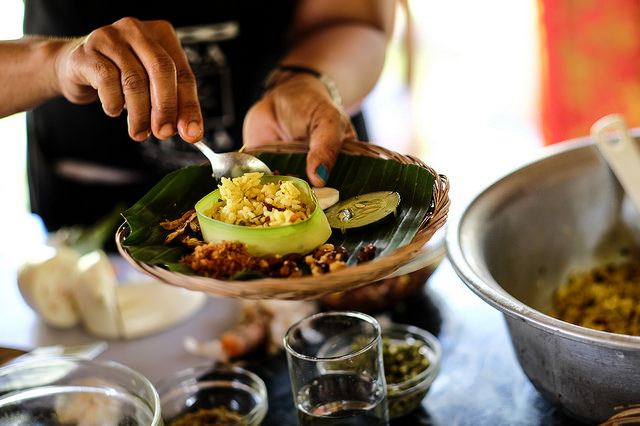 Beautiful Indonesian food being plated – image by Matt Oldfield
Beautiful Indonesian food being plated – image by Matt Oldfield
6. In your opinion where are the best restaurants/cafes or places to eat authentic Indonesian cuisine or experience real regional cooking?
The best authentic Indonesian cuisine restaurants in Jakarta are Soto Ambengan Pak Sadi, Soto Betawi H. Maruf, Resto Padang Sederhana, Resto Manado Beautika, dan Coto Makassar Daeng Tata.
7. Are there any special utensils we should be using when cooking Indonesian food?
There are no special utensils, just that instead of using a food processor, Indonesians love using mortar and pestle to make sambal or to grind spices.
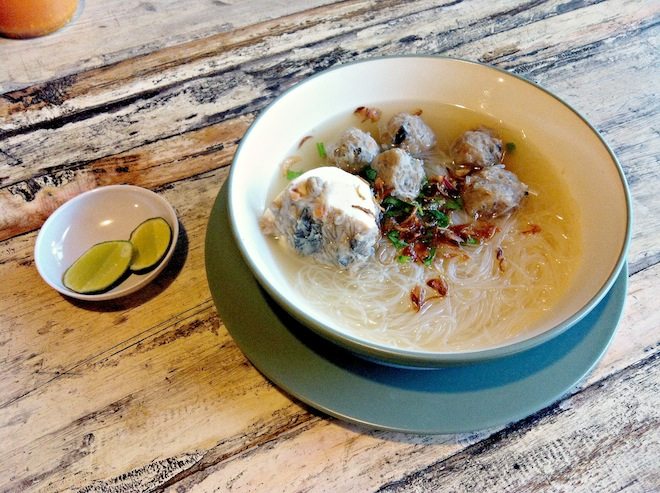 One of my personal Indonesian favourites, Bakso Bintik
One of my personal Indonesian favourites, Bakso Bintik
8. What is your favourite Indonesian dish?
My most favourite Indonesian dish is Sambal Tempe; it’s deep fried tempe mixed with chili, garlic, coriander and salt sambal, coarsely mashed. I eat it with hot rice, very delicious!
– Indonesian Recipes –
Ibu has shared two recipes suitable for even beginner cooks below!
LODEH IRIS (Vegetable soup with coconut milk)
Serves 4
Ingredients
2 tbsp frying oil
3 red onions, sliced
2 cloves of garlic, sliced
1 large red chili, sliced
1 large green chili, sliced
5 cm galangal, crushed
3 bay leaves
500 ml of water
1 tsp salt
1 tsp pepper
1 tbsp sugar
1 pumpkin, diced
1 purple eggplant, sliced
3 beans, sliced
2 pieces of cabbage, sliced
200 ml coconut milk
Method
Heat oil, sauté onion, garlic, red chili, green chili, ginger and bay leaves until wilted, put some water, add salt, pepper and sugar.
Add pumpkin, eggplant, beans and cabbage and heat until the vegetables are cooked.
Add the coconut milk, stir, and cook until boiling, remove from heat.
Serve.
CHICKEN STEW
Serves 6
Ingredients
1 whole chicken (weighing 900 grams, cut into 20 parts)
1 tbsp lemon juice
1 tsp salt
150 ml soy sauce
6 lime leaves
5 cm ginger
10 cm cinnamon
10 cloves
1 crushed nutmeg
500 ml of water
2 tablespoons cooking oil
8 red onions/shallots, crushed
1 teaspoon salt
1 teaspoon pepper
To serve:
Sliced tomatoes
Greens
Fried onions
Method
Wash the chicken and coat with lemon juice. Let it stand for 10 minutes, wash it again, then drain.
Heat oil, sauté ground spices together with the lime leaves, ginger, cinnamon, cloves and nutmeg, until fragrant.
Add the chicken pieces and cook until it changes colour
Add soy sauce, salt and pepper, stir, and cook briefly.
Add water, cook until the chicken is tender and sauce thickens, remove from heat.
Serve warm with sliced tomato, greens and sprinkle with fried onions
You’ll also like:
Travel: Jakarta Restaurants Mini Guide
Foodie Profile #17 – Janet DeNeefe
Travel: Locavore Restaurant Ubud




